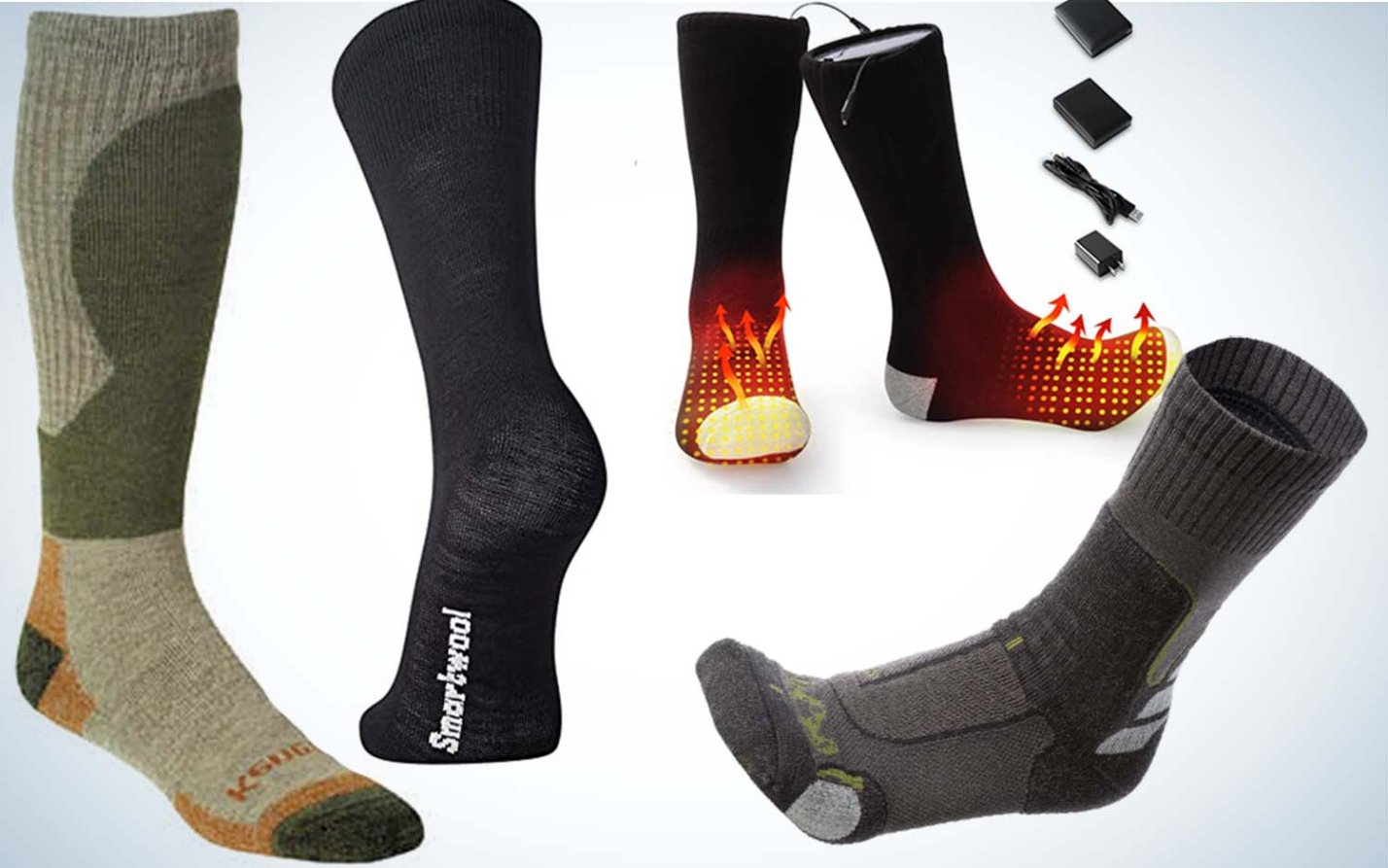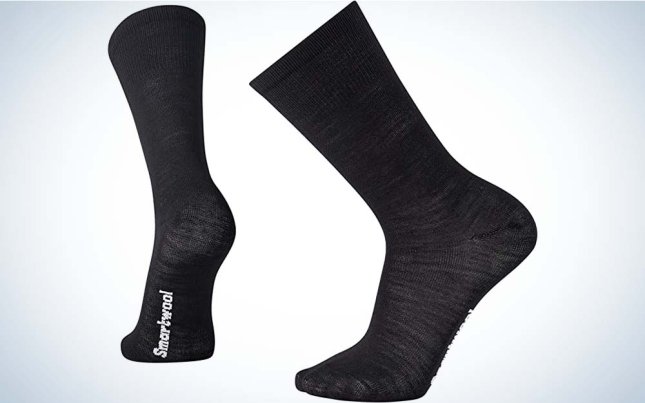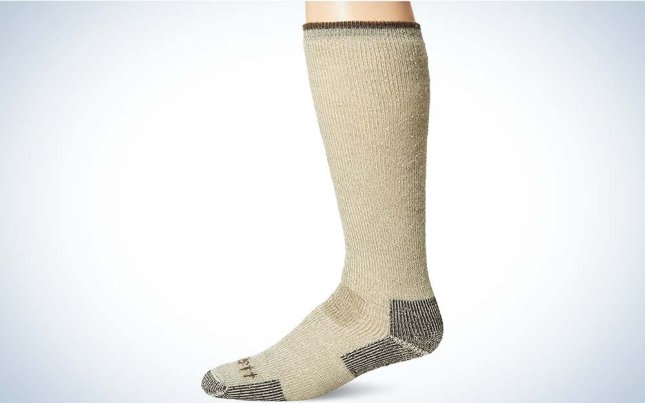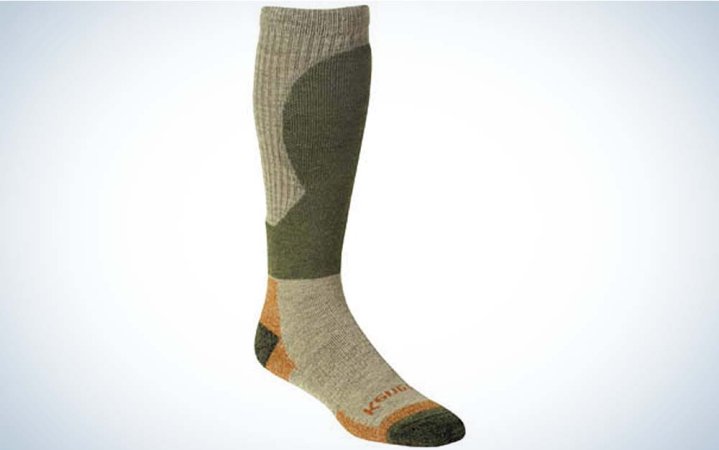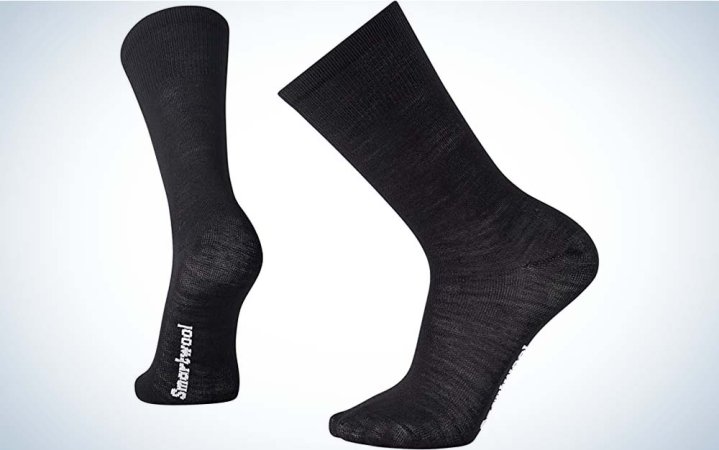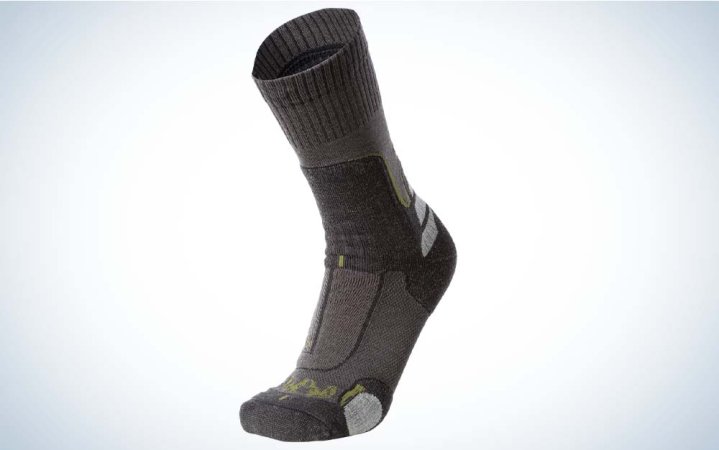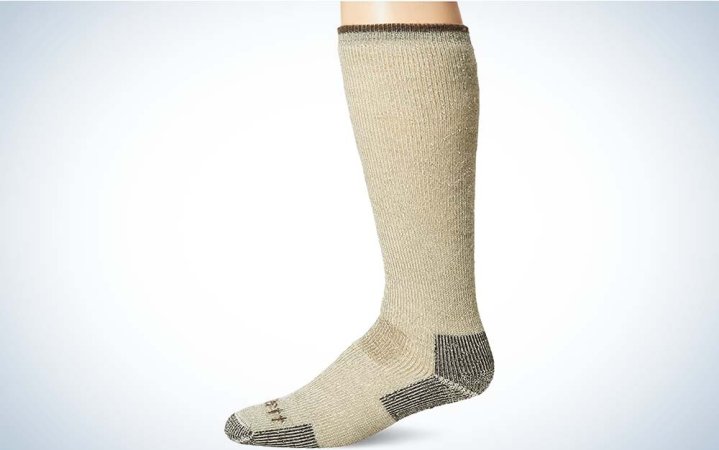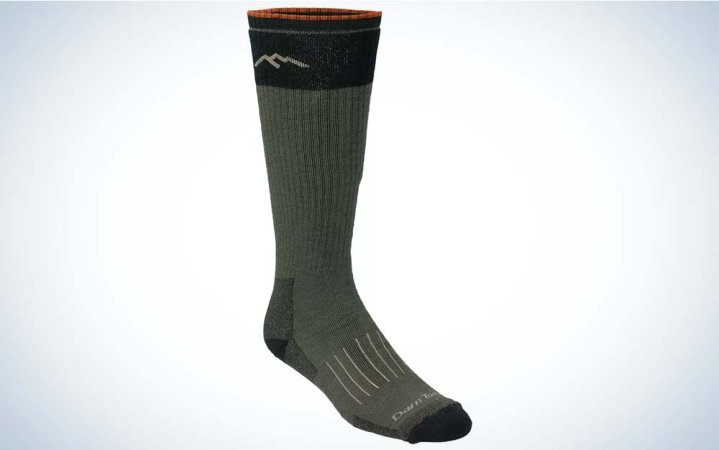We may earn revenue from the products available on this page and participate in affiliate programs. Learn More ›
Your feet are critical to your performance and happiness while hunting and that starts with quality hunting socks. Without them, blistered feet can stop backcountry hunters in their tracks and frozen feet can end a rut sit early for whitetail hunters. Luckily today’s hunting socks aren’t just comfortable, they’re great at wicking moisture, preventing blisters, and keeping your feet warm. And hunters who have used lesser socks quickly point out that today’s top-end models have made moisture-holding and blister-creating cotton obsolete. While we’ve come along way from hunting in gym socks, choosing a hunting sock isn’t as simple as walking into a store and tossing a pair or three in your shopping cart. It’s hard to know which socks perform best without dropping some serious cash to buy multiple pairs. But, to eliminate all that guesswork and hopefully save you a few bucks, I tested the best hunting socks on everything from elk to goose hunts in various boots, and weather conditions to help narrow down your decision.
- Best Overall: Kenetrek Canada Midweight Over-the-Calf
- Best Lightweight Liner: Smartwool Hiking Liner Crew Socks
- Best Midweight for Mountains: KUIU Midweight Mountain Sock
- Best for Late Season: Carhartt Arctic Heavyweight Wool Boot
- Best Heated: Weston Rechargeable Heated Sock
- Best for Women: Women’s Darn Tough Over-the-Calf Heavyweight
How I Chose the Best Hunting Socks

For this review, I wore these socks inside multiple boots in various terrains and weather conditions. I also kept meticulous details on how each sock performed and placed emphasis on sock durability, comfort, and warmth. If a particular sock didn’t fit the bill, I didn’t include it in this review. Each of the socks in this article, even those mentioned in the FAQs section, make great options depending on your hunting scenarios.
Best Hunting Socks: Reviews and Recommendations
Best Overall: Kenetrek Canada MidWeight Over-the-Calf Sock
Key Features
- Merino wool/polypropylene blend
- Men’s and women’s sizes
- Heel, toe, and shin pads
Pros
- No lace pressure
- Insulates when damp
- Comfortable
- Breathable
- Versatile
Cons
- Pricey
- Ankle fit could be better
If I had to take one sock to the woods for the rest of my days, it would be Kenetrek’s Canada MidWeight. I love the over-the-calf feel, and the sock has the perfect blend of softness and durability. I’ve had my pair for two years and put hundreds of miles on them. They dry quickly and though warm, don’t promote foot sweat. You can use this sock from the early season to the late season because they wick moisture so well. And the fitted pads on the toe, heel, and shin promote extra comfort. You can wear this sock with a liner, but I recommend using it as a standalone.
Best Lightweight Liner: Smartwool Hiking Liner Crew Socks
Key Features
- Crew height
- Flat knit toe seam
- 59 percent Merino wool
Pros
- Easy to care for
- Durable
- Comfortable
- Multiple uses
Cons
- A tad too thin
These are my go-to liner socks, and I’ve walked hundreds of miles using them as an early-season standalone. Though they’re a crew sock, they stay up nicely and hug the ankle. And the thin build makes them easy to dry if they get sweaty or wet with moisture. You can store several pairs of these socks in your pack, and I’ve found that even after multiple days on the mountain, I don’t gag my buddies when I take my socks and shoes off to let them dry out. You can toss these socks in a warm washing machine, but I’ve doused them in an icy stream with scent-free soap more than once, and they’ve held up wonderfully.
Best Midweight for Mountains: KUIU Midweight Mountain Sock
Key Features
- 55 percent merino wool
- 2.5 ounces (pair)
- Paladin protection pad
Pros
- Durable
- Insulates when wet
- Odor resistant
- Comfortable
Cons
- Crew socks (not over the calf)
- Pricey
Though I’d love to see KUIU make its Midweight Mountain Sock in an over-the-calf model, I won’t turn my nose up at this build. This is one of the best mountain socks I’ve ever worn. The socks provide a unique blend of warmth and comfort, and though they can get a little sweaty, especially during the early season, the material dries quickly. Once dry, the sock is soft and ready to go again, and they don’t turn crinkly or stiff. These socks have an uncanny ability to keep you cool on hot days and warm when the mercury drops. They fit brilliantly, and the comfort is noticeable when traversing rugged terrain, especially with weight on your back.
Best for Late Season: Carhartt Arctic Heavyweight Wool Boot
Key Features
- 68 percent wool
- Over-the-calf fit
- Anti-odor technology
Pros
- Stays up on the ankle
- Durable
- Under $18 per pair
Cons
- Not many size options
There’s nothing fancy about these socks, but when you use it with a liner from Smartwool or Kenetrek, you can count on them to keep your feet super warm. I’ve worn these socks from the frozen Rockies to the snow-covered goose fields in late January, and they always keep my feet toasty. I appreciate their length, how they hug the ankle, and they hold up to machine washing. I’ve had two pairs for the last two years, and both look and feel like new.
Best for Women: Darn Tough Women’s Hunter Over-the-Calf Heavyweight Hunting Sock
Key Features
- 79 percent merino wool
- Mesh top panel
- Multiple sizes
- High-density knitting
Pros
- All-weather performance
- Great moisture wicking
- Full cushion build
- Durable
Cons
- Can run too warm during early season
- Little pricey
Darn Tough’s Women’s Over-the-Calf Heavyweight is designed for on the go hunts during the mid-and late-season. My wife raves about the fit and feel of the sock and appreciates the lifetime guarantee. Darn Tough dubs these socks as cool during the summer and warm during the winter, but my wife noted that these socks are sauna-like when she wears them with boots during the hot summer months. When we hunt ducks and geese in December and mule deer in November, these socks’ heavyweight build shines through and keeps her feet warm, comfortable, and most important to her, blister-free.
Things to Consider Before Buying Hunting Socks
My father, who doesn’t hunt, joined me on a recent trip to a sporting goods store. My mission: find socks for an upcoming hunt. It didn’t take him long before he became agitated with me. He kept asking, “Would you pick one, please? A sock is a sock.” False. A hunting sock is far from just a sock. And the right pair can mean the difference in filling your tag or going home early. Even the best men’s socks won’t work if you don’t have the right pair for the job. For instance, I hunted elk with a guy once who had to leave on day three after packing eight miles into a wilderness area due to multiple quarter-sized blisters on his feet. Sadly, it was mid-September, and the bulls in the no-name drainage were going ballistic. I killed a nice 5×5 on the third morning of the hunt while my buddy made his way back to the truck to nurse his wounds.
Lightweight/Liners
Early-season hunters who roam the mountains searching for big-game nirvana will want a sock that’s light, comfortable, and wicks away moisture. A calf or over-the-calf high choice is always a good option, and I prefer a sock that comes up over my calf and keeps my legs dry when dewy morning meadows try their best to soak my lower garments. A liner sock, like a primary crew made from merino wool or polypropylene, should also be considered. You can wear the liner as a standalone sock and on days when the temperature drops, you can pair the thin liner with a slightly heavier over-the-calf sock. It’s a system that I’ve found works well. Socks roll up to almost nothing and store easily in a pack, so I always tote a few options.
Midweight
October and November treestand deer hunters should go another route or those that use ground blinds or shooting houses. During stationary hunts, blood flow slows, especially to your feet. Even though temps aren’t frigid, your toes get cold. And when warmth leaves your feet, your enthusiasm for hunting might leave with it. Consider a midweight or heavyweight over-the-calf sock for sit-and-wait hunts during these months. I like a 60- or 70-percent merino wool mixture paired with lycra and nylon.
Heavyweight
Spot-and-stalk hunters can stay with an excellent heavyweight over-the-calf sock during the late season. Walking generates blood flow, and your feet won’t get as cold as you would during a stationary hunt. Be sure to choose a sock design that wicks away moisture. You don’t want your feet to feel like they are floating in a warm water pool when you stop. That sweat can turn cold quickly, and your feet will start to freeze.
Late-season sit-and-waiters should go with a liner system and place a heavyweight sock over the top of the liner for maximum warmth and thermoregulation. There are also some great battery-operated socks to consider. Battery-operated socks typically aren’t the most comfortable to walk in, but since you’ll be spending most of your time in one location, warmth should get the nod here.
FAQs
There are plenty of great options for hunting socks, but it’s hard to go wrong with merino wool. Personally, I prefer a merino wool/nylon blend. Nylon adds durability, and both nylon and merino wool dries quickly in the field. If your feet get wet, the merino wool will continue to provide insulation.
Wearing a sock liner isn’t a must, and you can get by without them. However, I typically wear them on early- and mid-season backcountry hunts. Liner socks take up very little room in the pack, and I like to have several pairs at my disposal. Most of the time, a good liner is all I need, but if the temperature drops or my feet need a little more padding, I can add a midweight or heavyweight sock over the liner. Liner socks dry quickly, and most have a build that wicks away moisture from the feet.
How often you change your socks depends on what you’re hunting and where your hunt occurs. For instance, if you’re whitetail hunting and headed back to the house or cabin each night, I recommend wearing a new pair of socks each time you walk out the door. Today’s socks are fantastic, and many resist odor, but nothing smells worse than sweaty feet, and the last thing you want to do is pollute the inside of your rubber boots.
On the flip side, if you’re in the backcountry hunting elk and mule deer and living out of your pack, I recommend taking your socks and shoes off every single time you stop for a good break. It’s always good to let your feet air out and let your socks and shoes dry. If you stay on top of this, you can wear the same socks for two or three days. However, you’ll want to tote a few spares in your pack. I carry one extra liner, two extra midweight pairs, and one heavyweight pair in a dry bag. Socks don’t add much weight, and it’s always nice to slide your feet into a fresh pair.
My feet don’t sweat much, but my 16-year-old son’s feet could fill a kiddie pool. His go-to is Wigwam’s Gobi Liner, but he has also had great success with Kenetrek’s Ultimate Liner Lightweight Over-The-Calf Sock and Smartwool’s Hiking Liner Crew Socks.
I’m a distance runner, and I love a low-cut sock. But for hunting, unless you plan to use a sound gaiter system, low-cut won’t suffice. I’ve tried it, and I spend too much time digging around in my boots to remove blister-causing debris. I do pack a pair of low-cut Smartwool running socks in my pack, but I only use them when walking around camp in Crocs.
I like to hang my socks on a twig or some make-shift stand next to a fire. Be careful, though. Too many hunters rush the process and try to get the socks too close to the flame. I’ve seen wool go up in a blaze, and sparks melt right through nylon and polypropylene. Keep your socks a good distance from the fire, and they will dry quickly. Another great drying tip is to hang them from a pine limb during a warm mountain day. Materials like merino wool, nylon, lycra, and others dry quickly.
Final Thoughts on the Best Hunting Socks
Sock choice matters. Besides your boots, socks are the next most crucial piece of hunting gear. If you don’t have the best hunting socks to take care of your feet and keep them warm, dry, comfortable, and free of blisters, your hunting experience can go south in a hurry.
